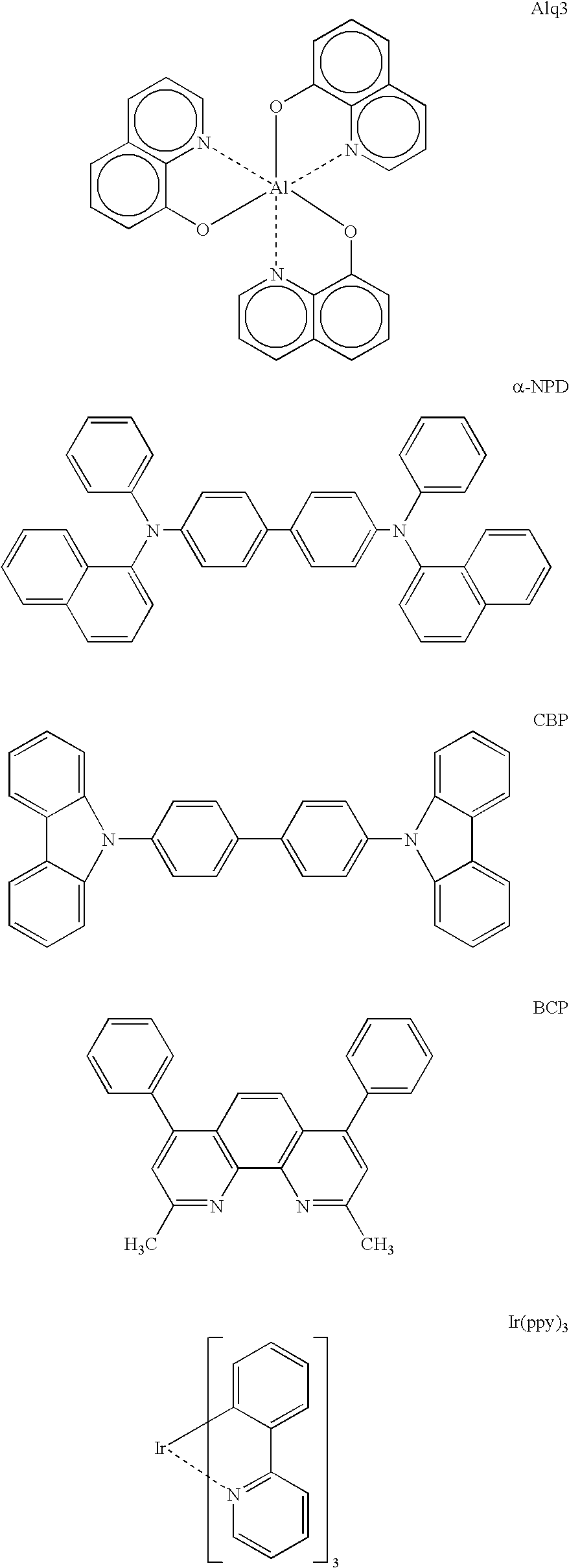Luminescence device, display apparatus and metal coordination compound
a technology of metal coordination compound and light source, which is applied in the direction of group 3/13 element organic compound, group 5/15 element organic compound, natural mineral layered product, etc., can solve problems such as luminescent deterioration
- Summary
- Abstract
- Description
- Claims
- Application Information
AI Technical Summary
Benefits of technology
Problems solved by technology
Method used
Image
Examples
examples 11-16
In these examples, metal coordination compounds of formula (1) (Compounds 11-16) were used in respective luminescence layers for Examples 11-16, respectively. ##STR12## ##STR13##
Each of luminescence devices having a structure shown in FIG. 1C were prepared in the following manner.
On a glass substrate (transparent substrate 15), a 100 nm-thick film (transparent electrode 14) of ITO (indium tin oxide) was formed by sputtering, followed by patterning to have an (opposing) electrode area of 3 mm.sup.2.
On the ITO-formed substrate, three organic layers and two metal electrode layers shown below were successively formed by vacuum (vapor) deposition using resistance heating in a vacuum chamber (10.sup.-4 Pa).
Organic layer 1 (hole transport layer 13) (40 nm): .alpha.-NPD
Organic layer 2 (luminescence layer 12) (20 nm): mixture of CBP: metal coordination compound of formula (1) (93:7 by weight)
Organic layer 3 (exciton diffusion prevention layer 17) (10 nm): BCP
Organic layer 4 (electron transpo...
example 17
Synthesis of Compound 11
##STR15##
In a 200 ml-four necked flask, 100 ml of glycerol was placed and heat-stirred for 2 hours at 130-140.degree. C. while supplying nitrogen gas therein in the form of bubbles, followed by cooing to 100.degree. C. by standing. To glycerol, 1.94 g (12.00 mM) of 2-(2-thienyl)pyridine and 1.00 g (2.0 mM) of Iridium (III) acetylacetonate were added, followed by heat-refluxing for 8 hours under stirring in nitrogen gas stream.
After the reaction, the reaction mixture was cooled to room temperature and poured into 600 ml of 1N--HCl. The resultant precipitate was recovered by filtration and washed with water, followed by drying for 4 hours at 100.degree. C. under reduced pressure and purification by silica gel column chromatography (eluent: chloroform) to obtain 0.38 g of Iridium (III) tris[2-(2-thienylphenyl)pyridine) (red powder) (Yield: 28.2%).
example 18
Synthesis of Compound 12
##STR16##
In a 1 liter-three necked flask, 33.70 g (185.8 mM) of 2-chloro-5-trifluoromethylpyridine, 23.77 g (185.8 mM) of thiophene-2-bronic acid, 200 ml of toluene, 100 ml of ethanol and 200 ml of 2M-sodium carbonate aqueous solution were placed and stirred in a nitrogen gas stream at room temperature. Under stirring, to the mixture, 6.66 g (5.76 mM) of tetrakis (triphenylphosphine) palladium (0) was added, followed by heat-refluxing for 5 hours under stirring in nitrogen gas stream.
After the reaction, the reaction mixture was cooled, followed by extraction with cool water and toluene. The organic layer was washed with water until the system showed neutral, followed by distilling off of the solvent under reduced pressure to obtain a residue. The residue was purified by silica gel column chromatography (eluent: toluene / hexane=2 / 1) and recrystallized from ethanol to obtain a pale yellow crystal. The crystal was purified by alumina column chromatography (eluent...
PUM
| Property | Measurement | Unit |
|---|---|---|
| emission spectrum peak wavelength | aaaaa | aaaaa |
| dipole moment | aaaaa | aaaaa |
| thickness | aaaaa | aaaaa |
Abstract
Description
Claims
Application Information
 Login to View More
Login to View More - R&D
- Intellectual Property
- Life Sciences
- Materials
- Tech Scout
- Unparalleled Data Quality
- Higher Quality Content
- 60% Fewer Hallucinations
Browse by: Latest US Patents, China's latest patents, Technical Efficacy Thesaurus, Application Domain, Technology Topic, Popular Technical Reports.
© 2025 PatSnap. All rights reserved.Legal|Privacy policy|Modern Slavery Act Transparency Statement|Sitemap|About US| Contact US: help@patsnap.com



